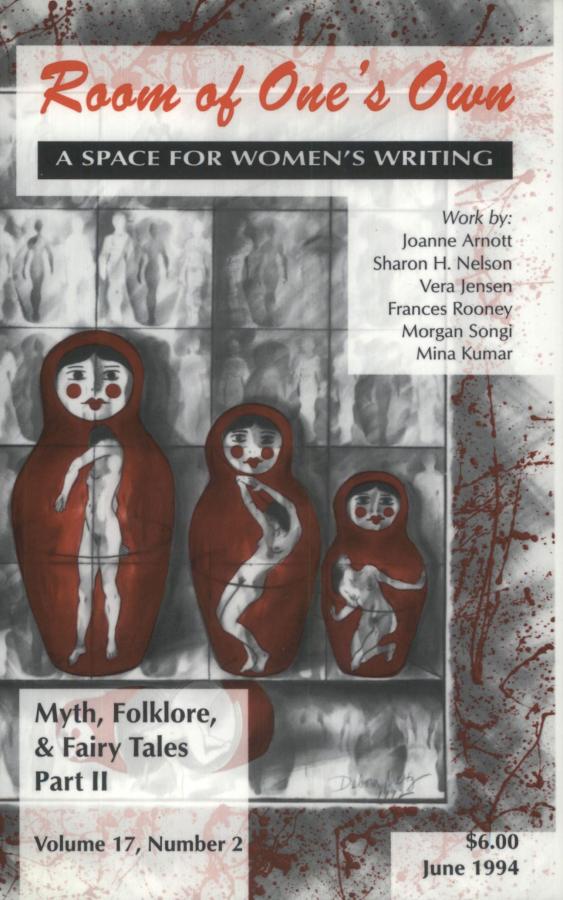Myth, Folklore and Fairy Tales Part II | 17.2
1994
Digital only; out of stock in print.
This is the second half of out special, two-part series in which women have revisioned myth, folklore, and fairy tales. The stories of the first issue were, for the most part, fashioned from existing tales: Greek myth, Bible stories, fairy tales, coyotisma. In this issue, we digress from “once upon a time” to “once upon a modem time,” many of the stories having contemporary settings. Elizabeth Ukrainetz, for example, adapts the classic Baba Yaga tale in herstory of “Over Time. ”The archetypal witch may have been replaced by a demanding boss and the magic doll by an old woman, but Ukrainetz has not changed the basic elements: a woman unfairly treated, three impossible tasks, charitable assistance from an unexpected source, and justice in the form of self-destruction of the evil taskmaster. (For a remarkable, affirming analysis of this tale, see “Vasalisa” in Women Who Run With the Wolves (Ballantine Books, New York, 1992) by Clarissa Pinkola Estés.)
The complement of tales in this issue is made up of a variety of revisioned women in allourglory — from the wise to the foolish, the sweetest to the most bitter. Neither are the story endings all tidy, as traditional ones tend to be. Each author brings a fresh view to the roles we find thrust upon us (often unwillingly), holding the essence to the light to see what will be.revealed. Do we ignore stereotypes or confront them head-on? Where does stereotyping end and individuality begin? Do we use traditional frames for our tales or make a drastic departure. Where to? Does the moral of the story need to be obvious? Must there be a redemptive ending? How many ways can a tale be interpreted?
Often, the stories push the limits of the social and cultural myths that we are expected to fit. For instance, Sháron H. Nelson tears apart the social construction of woman as target of the male gaze, and gives us an empress who—unlike the emporer who wore no clothes—does not bend to her would-be advisors.Tanis MacDonald shows us alively alternative to the mermaid who forfeits her tail for her lover. The protagonists in the Allison Goodwin Wilmington and Loretta Anawalt tales are astute adventurers. Vera Jensen revisions the role of the witch.
Just what does a feminist tale look like? The authors of “Essa’s Question,”Mamina Gonick and Kelly McDowell, were very aware of how feminist fairy tales might look. In the notes accompanying their tale, they reported that “we wondered about the possibilities of moving beyond an economy of stereotypes and decided that the only way to find out was to try [writing one] ourselves. The result is… an ironic twist on our ideals and our original intent. Although it presents the task of identity construciton as problematic, and as an ongoing, open-ended accomplishment, it neglects the processes which make identity problematic in the first place. It was strange to find, after creating a so-called feminist tale, that our main character, in essence, didn’t have a body. Essa’s dilemma centres on the issues of choice. As a starting point, our issues as feminists was not over which body to choose, but rather which meanings we choose and which are assigned to our bodies. Or said differently, our problem or issue was not with the bodies we have but with the meanings and signs they carry. The other irony found in our attempt to move beyond conventions was our explicit use of them. It seemed, upon reflection, that they were the only tools readily at hand. The question of how we can use the technology we seek to disrupt has brought us back to the very questions we sought to solve in the first place. Our question now is whether there is an answer. Perhaps the answer is in the questioning.”
Questioning is perhaps the single common thread to the pieces in this collection. The breadth and depth of the authors’ capacities to examine the cloak of stereotypes, separate the critical components, and fashion new garments that weigh less heavily on our shoulders earn them the badges of expert seamstresses of concepts—and perhaps of conscience. Hopefully this issue contains a question for everyone, and at least one answer.
—Wendy Putnam

$10.00
Additional information
| Delivery | Canada, USA, International, Digital |
|---|
In this issue: Laura Ardiel, Loretta Anawalt, Joanne Arnott, Diane Collet-Larichellière, Mary Fish, Marnina Gonick, Vera Jensen, Mina Kumar, Tanis MacDonald, Kate McCandless, Kelly McDowell, Debora Meltz, Sharon H. Nelson, Lisa Pasold, Wendy Putman, Pauline Rankin, Faye Scott Rieger, Frances Rooney, Lorna Schwenk, Morgan Songi, Esta Spalding, Elizabeth Ukrainetz, Allison Goodwin Wilmington